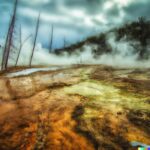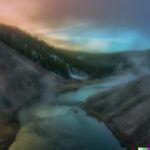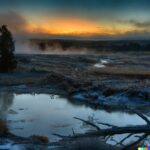Have you ever wondered about the majestic Castle Geyser located in Yellowstone National Park? This article will take you on a journey to discover what makes Castle Geyser unique, from its size and shape to its eruption patterns. We will delve into the history of this natural wonder, including its first recorded eruption and changes over time.
Learn about the eruption schedule, how to view Castle Geyser safely, and explore other nearby geysers like Old Faithful and Grand Geyser. Join us as we uncover the beauty and wonder of Castle Geyser and its surrounding features.
What Is Castle Geyser?
Castle Geyser, located in Yellowstone National Park, is a prominent thermal feature known for its iconic eruptions, cone structure, and status as a geothermal landmark.
This geyser stands out for its towering cone, which is shaped by layers of mineral deposits that have accumulated over centuries. Its eruptions, though not as frequent as other geysers in the park, are majestic and can reach impressive heights. The unique geological presence of Castle Geyser captures the attention of visitors, drawing them in with its captivating display of power and natural beauty. Its historical significance within the park further enhances its allure, making it a must-see attraction for those exploring Yellowstone’s wonders.
Where Is Castle Geyser Located?
Castle Geyser is situated in the mesmerizing surroundings of Yellowstone National Park in Wyoming, United States, drawing visitors from around the world as a popular tourist attraction.
Nestled amidst the stunning natural beauty of the park, Castle Geyser stands out for its unique cone shape and impressive eruptions, reaching heights of up to 90 feet. Its location near the Firehole River adds to the picturesque setting, offering visitors a chance to witness the geyser’s spectacular displays against the backdrop of lush forests and rugged mountains.
As one of the iconic features of Yellowstone’s geothermal landscape, Castle Geyser showcases the park’s volcanic activity and geothermal wonders, captivating both nature enthusiasts and casual tourists alike.
How Was Castle Geyser Formed?
The formation of Castle Geyser can be traced back to volcanic activity, mineral-rich water sources, and intricate geologic processes that have led to its cone structure and mineral deposits.
Volcanic influences played a significant role in the creation of Castle Geyser. In Yellowstone National Park, the geyser is situated amidst a region characterized by underlying volcanic activity, with hot magma reservoirs heating groundwater. This heat, combined with the presence of minerals dissolved in the water, pressures the water to rise through fissures in the Earth’s crust. As the superheated water reaches the surface, it creates the iconic eruptions that catapult steam and water high into the air, leaving behind the distinct cone formation and colorful mineral deposits that are hallmarks of Castle Geyser and other geysers in the park.
What Makes Castle Geyser Unique?
Castle Geyser stands out for its distinctive eruptive patterns, captivating geothermal features, steaming vents, and interconnected hydrothermal systems that make it a geological wonder in Yellowstone National Park.
- This remarkable geyser’s eruptive behavior is a sight to behold, with its towering bursts of water and steam that can reach up to 90 feet high, creating a mesmerizing display against the backdrop of the park’s natural beauty. Its geothermal features, such as colorful mineral formations, add to its allure, drawing visitors to witness the ever-changing landscape shaped by the geyser’s activity.
- The steam vents surrounding Castle Geyser emit a constant hiss, adding to the mysterious ambiance of this unique geological marvel. The complex hydrothermal systems beneath the geyser contribute to its dynamic nature, showcasing the intricate underground processes that power its impressive eruptions.
Size and Shape
Castle Geyser’s impressive size and distinctive cone structure set it apart from other geysers in Yellowstone National Park, showcasing the fascinating geological formations that define its visual appeal.
Standing tall and proud, Castle Geyser’s cone rises gracefully into the sky, drawing the eyes of visitors towards its majestic presence. The size of the geyser’s cone is a testament to the power and force of the underground thermal activity that fuels its eruptions.
The shape of Castle Geyser’s cone is unique, with intricate layers of mineral deposits creating a captivating display of colors and textures. Its cone structure resembles a towering castle, hence the fitting name that adds to its allure within the park’s diverse landscape.”
Eruption Patterns
The eruption patterns of Castle Geyser reveal a rich eruptive history characterized by distinct behaviors and unique eruptive characteristics that have mesmerized geology enthusiasts and visitors alike.
Its eruptions, which typically occur every 10 to 12 hours, can reach impressive heights of up to 90 feet, making it a prominent feature in Yellowstone National Park. The geological significance of Castle Geyser lies in its cone-shaped structure, formed by silica-rich mineral deposits over centuries.
Visitors are captivated by the dramatic buildup of steam and water before the geyser’s explosive release, creating a visually stunning spectacle against the backdrop of the park’s natural beauty.
Surrounding Features
Castle Geyser’s surroundings are enhanced by the mesmerizing Norris Geyser Basin, creating a picturesque geothermal landscape that showcases the diverse beauty of Yellowstone’s geothermal features.
The steaming vents, bubbling hot springs, and colorful microbial mats surrounding Castle Geyser offer a sensory feast for visitors, immersing them in a world shaped by the Earth’s natural forces. The symbiotic relationship between the various geothermal features in the Norris Geyser Basin adds to the allure of Castle Geyser, making it a must-see attraction for those exploring the park. The bubbling pools of water, vibrant mineral deposits, and hissing steam vents create a dynamic fusion of sights and sounds, giving a glimpse into the raw power and beauty of Yellowstone’s geothermal landscape.
What Is the History of Castle Geyser?
The history of Castle Geyser dates back to its first recorded eruption, revealing a timeline of changes over time that have shaped its current geological presence and eruptive behavior.
Originally documented in the late 19th century during the early days of Yellowstone National Park’s exploration, Castle Geyser was noted for its towering bursts of water reaching up to 90 feet in height. The geyser’s distinctive cone, resembling a castle turret, led to its name. Over the years, fluctuating thermal activity has influenced the intervals between eruptions, varying from once every 9 hours to irregular patterns, providing a captivating spectacle for visitors and researchers alike.
First Recorded Eruption
The eruption of Castle Geyser’s first recorded eruption marked the beginning of a series of captivating eruptive events that showcased the geologic activity and unique nature of this iconic geyser.
The eruption of Castle Geyser, recorded in the late 19th century, fascinated onlookers with its majestic display of boiling water and steam shooting high into the air. This event kickstarted a pattern of eruptions, each further solidifying the geyser’s reputation as one of Yellowstone National Park’s must-see attractions. Over the years, Castle Geyser continued to exhibit its power, with eruptions reaching impressive heights and durations, captivating visitors with its unrivaled beauty and force of nature.
Changes Over Time
Over time, Castle Geyser has undergone changes in its eruptive nature, revealing the dynamic and ever-evolving geologic wonder that continues to captivate visitors with its unique characteristics.
Visitors have observed a shift in the frequency and intensity of Castle Geyser’s eruptions, with periods of increased activity followed by relative calm. This fluctuation in behavior adds to the mystique surrounding this natural spectacle, highlighting its unpredictable yet mesmerizing allure.
Some researchers attribute these variations to underground geological processes that impact the geyser’s plumbing system. Despite these changes, Castle Geyser remains a prime example of the dynamic nature of geothermal features, serving as a reminder of the remarkable forces at play beneath the Earth’s surface.
What Is the Eruption Schedule for Castle Geyser?
Understanding the eruption schedule for Castle Geyser involves monitoring its eruption cycle and studying its distinct eruptive behavior, offering insights into the rhythmic patterns of this captivating geothermal wonder.
The cycle of Castle Geyser’s eruptions typically follows a routine pattern, where it experiences a major eruption followed by a period of dormancy. This behavior is governed by the accumulation of pressure beneath the geyser, causing it to release a powerful burst of water and steam into the air.
Visitors and geothermal enthusiasts can observe these patterns by studying the intervals between eruptions and the duration of each event. By recognizing these cycles, viewers can enhance their experience and appreciation of Castle Geyser’s natural spectacle.
How to View Castle Geyser?
Experiencing Castle Geyser involves understanding its accessibility, determining the best time to visit for optimal viewing, and adhering to essential safety tips to enjoy this natural wonder responsibly.
When planning your trip to see Castle Geyser, be sure to check the current accessibility options available. The geyser is located in the Upper Geyser Basin of Yellowstone National Park, and there are designated pathways and viewing areas for visitors. To witness the impressive eruptions, it is recommended to visit during the early morning or late afternoon when the lighting is favorable and the crowds are usually smaller. Remember to maintain a safe distance from the geyser to avoid the scalding hot water and steam. Pack essentials like water, sunscreen, and sturdy footwear for a comfortable exploration.
Accessibility
Castle Geyser’s accessibility allows visitors to witness the drama of its eruptions up close, providing a unique opportunity to experience one of Yellowstone’s most iconic landmarks in all its glory.
The observation area near Castle Geyser offers a prime vantage point to marvel at the thermal spectacle as it shoots water high into the air against a backdrop of the park’s stunning natural beauty. Visitors can feel the heat of the geyser as it roars to life, a truly captivating experience that immerses you in the raw power of nature. Exploring the surrounding boardwalks and trails provides a deeper insight into the geothermal wonders of Yellowstone, making the visit to Castle Geyser a comprehensive adventure.
Best Time to Visit
Determining the best time to visit Castle Geyser involves considering temperature fluctuations, the thermal reservoir’s activity, and the optimal conditions that enhance the viewing experience of this geothermal marvel.
By visiting Castle Geyser during periods of warmer weather, typically in the summer months, visitors can experience more frequent eruptions and heightened thermal activity. The increased temperatures during these times often lead to more dramatic water displays, adding to the awe-inspiring spectacle.
Early mornings or late afternoons are recommended for a more tranquil and less crowded experience, allowing visitors to immerse themselves fully in the impressive natural beauty of Castle Geyser. Timing your visit to align with these conditions can truly maximize your overall enjoyment and appreciation of this geological wonder.
Safety Tips
When visiting Castle Geyser, it is crucial to observe safety tips to avoid the scalding waters, respect the mineral deposits, and appreciate the natural beauty of this geothermal attraction without endangering oneself or the environment.
Be mindful of the designated pathways and boardwalks, as stepping off these can lead to accidental burns from the extremely hot geothermal waters. Avoid placing your hands or any body part in the water, as it can cause severe burns due to the high temperatures.
Refrain from touching or damaging the colorful mineral deposits surrounding the geyser, as these formations are fragile and play a vital role in the ecosystem. Remember to carry out any trash you bring in and leave no trace to preserve the pristine environment for future visitors.
What Other Geysers Are Nearby?
In the vicinity of Castle Geyser, visitors can explore other notable geysers like Old Faithful, Grand Geyser, and Riverside Geyser, each offering a distinct geothermal spectacle within Yellowstone National Park.
- Old Faithful, known for its impressive regular eruptions that occur approximately every 90 minutes, is a must-see natural wonder.
- Grand Geyser, on the other hand, captivates visitors with its towering eruptions, sometimes reaching heights of over 200 feet, making it the tallest predictable geyser in the world.
- Riverside Geyser‘s unique setting along the Firehole River adds to its allure, providing a picturesque backdrop as it erupts high into the air.
These geysers, together with Castle Geyser, create a diverse and mesmerizing geothermal landscape for park visitors to experience.
Old Faithful
Old Faithful, an iconic geyser near Castle Geyser, is renowned for its predictable eruptive events that captivate visitors with a mesmerizing display of geothermal activity in Yellowstone National Park.
Its eruptions occur approximately every 90 minutes, shooting water and steam up to 180 feet into the air. The reliability of its eruptions has made it a must-see attraction for tourists from all over the world. The geothermal features surrounding Old Faithful add to the allure of the area, with bubbling hot springs and colorful microbial mats creating a unique natural landscape. Watching Old Faithful erupt against the backdrop of the rugged Yellowstone wilderness is a truly unforgettable experience for anyone who visits.
Grand Geyser
Grand Geyser, another impressive thermal feature close to Castle Geyser, showcases unique geological formations and mesmerizing eruptive patterns that contribute to the diverse geothermal landscape of Yellowstone National Park.
The mesmerizing display of Grand Geyser is not only a result of its geological formations but also its eruptive patterns that set it apart as a notable thermal feature in the park. This geyser is known for its predictable eruptions, often reaching heights of up to 150 feet, captivating visitors with its majestic power. As one observes the rhythmic bursts of steam and water shooting upwards against the backdrop of the surrounding geothermal scenery, the visual spectacle is truly awe-inspiring.
Riverside Geyser
Riverside Geyser, in proximity to Castle Geyser, is known for its hydrothermal eruptions that create enchanting thermal pools, adding to the allure of geothermal wonders in the vicinity of Yellowstone National Park.
These hydrothermal eruptions occur every 5.5 to 7 hours, shooting a column of water up to 75 feet high against the backdrop of the Firehole River. The thermal pools formed by the geyser’s activity display a mesmerizing palette of colors, ranging from vibrant blues to deep greens, due to the presence of different thermophilic bacteria thriving in the varying temperatures. Visitors often find themselves captivated by the dynamic display of nature’s forces seamlessly blending with the tranquility of the surrounding landscape.
Last Updated on February 8, 2024 by Jon Waraas – Originally Posted: February 8, 2024

I’m Jon Waraas, and I’ve been navigating the online world since 2006. By day, I’m the proud owner of some eCommerce gems, and by night, I’m the voice behind the adventures on Waraas.Com.
My heart, however, belongs to the wild beauty of Yellowstone National Park. I’ve got a collection of websites dedicated to sharing the wonders of this natural masterpiece. Oh, and did I mention? I’m currently building my own cabin inside the ghost town of Gilmore, Idaho – a cabin with tales to tell!
When I’m not immersed in the digital realm, you’ll find me lacing up my boots for a good hike or setting up camp under the star-studded sky.




